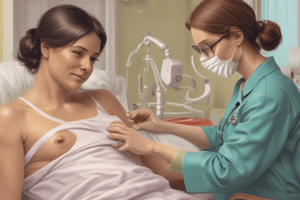Podcast
Questions and Answers
What is a key characteristic of Stage 1 Pressure Injury?
What is a key characteristic of Stage 1 Pressure Injury?
Non-Blanchable Redness of a localized area over a bony prominence
What does 'non-blanchable' mean in the context of a Stage 1 Pressure Injury?
What does 'non-blanchable' mean in the context of a Stage 1 Pressure Injury?
The redness does not go away when the skin is pressed.
Which part of the body is typically affected by Stage 1 Pressure Injuries?
Which part of the body is typically affected by Stage 1 Pressure Injuries?
Bony prominence
What does the red color in a Stage 1 Pressure Injury indicate?
What does the red color in a Stage 1 Pressure Injury indicate?
Why might the analogy of a red apple be used to describe Stage 1 Pressure Injuries?
Why might the analogy of a red apple be used to describe Stage 1 Pressure Injuries?
What is a common history factor for Incontinence Associated Dermatitis (IAD)?
What is a common history factor for Incontinence Associated Dermatitis (IAD)?
Where is a common location for Incontinence Associated Dermatitis (IAD)?
Where is a common location for Incontinence Associated Dermatitis (IAD)?
What symptoms are associated with Incontinence Associated Dermatitis (IAD)?
What symptoms are associated with Incontinence Associated Dermatitis (IAD)?
How are the edges of affected areas described in Incontinence Associated Dermatitis (IAD)?
How are the edges of affected areas described in Incontinence Associated Dermatitis (IAD)?
What is a distinguishing factor between the location of IAD and pressure ulcers?
What is a distinguishing factor between the location of IAD and pressure ulcers?
In the first image, is the skin intact or broken?
In the first image, is the skin intact or broken?
Does the second image show skin with or without infection?
Does the second image show skin with or without infection?
In the third image, what is the condition of the skin: intact or broken?
In the third image, what is the condition of the skin: intact or broken?
Does the fourth image show an infection?
Does the fourth image show an infection?
Which images show broken skin?
Which images show broken skin?
What is a common skin reaction observed in lighter skin tones?
What is a common skin reaction observed in lighter skin tones?
How does persistent erythema manifest in darker skin tones?
How does persistent erythema manifest in darker skin tones?
What differentiates erythema presentation in darker skin compared to lighter skin?
What differentiates erythema presentation in darker skin compared to lighter skin?
What is a typical characteristic of erythema in lighter skin tones?
What is a typical characteristic of erythema in lighter skin tones?
What skin color change is less likely to occur in darker skin tones?
What skin color change is less likely to occur in darker skin tones?
What is the main distinguishing factor of Category 1A in GLOBIAD stages of incontinence associated dermatitis?
What is the main distinguishing factor of Category 1A in GLOBIAD stages of incontinence associated dermatitis?
What additional criterion might you observe in a patient with Category 1B?
What additional criterion might you observe in a patient with Category 1B?
How does Category 2A differ from Category 2B in terms of infection?
How does Category 2A differ from Category 2B in terms of infection?
What persistent condition is a critical criterion in both 1A and 1B?
What persistent condition is a critical criterion in both 1A and 1B?
Which type of lesion suggests a fungal infection in Category 1B?
Which type of lesion suggests a fungal infection in Category 1B?
Name a critical criterion of Category 2 that involves skin damage.
Name a critical criterion of Category 2 that involves skin damage.
What feeling might a patient with Category 1B experience at palpation?
What feeling might a patient with Category 1B experience at palpation?
What type of infection is commonly associated with Category 2B?
What type of infection is commonly associated with Category 2B?
Which GLOBIAD category involves skin loss and no signs of infection?
Which GLOBIAD category involves skin loss and no signs of infection?
What additional symptom are found in both 1A and 1B?
What additional symptom are found in both 1A and 1B?
Flashcards are hidden until you start studying
Study Notes
Stage 1 Pressure Injury
- Intact skin with non-blanchable redness over a localized area, typically over bony prominence
- Characterized by capillary compromise within the skin layer
Differentiating Skin Tones
- In lighter skin tones, non-blanchable redness appears as red color
- In darker skin tones, non-blanchable redness appears as persistent erythema and hyperpigmentation
GLOBIAD Stages of Incontinence Associated Dermatitis
- Category 1: Persistent redness
- 1A: Persistent redness without clinical signs of infection
- 1B: Persistent redness with clinical signs of infection
- Category 2: Skin loss
- 2A: Skin loss without clinical signs of infection
- 2B: Skin loss with clinical signs of infection
Characteristics of GLOBIAD Stages
- Critical criteria: persistent redness, skin loss, signs of inflammation, satellite lesions
- Additional criteria: marked areas of discoloration, shiny appearance, macerated skin, intact vesicles and bullae, skin tension or swelling, burning, tingling, itching, or pain
Incontinence Associated Dermatitis (IAD) vs. Pressure Ulcer
- IAD: caused by urinary and/or fecal incontinence, affects perineum, perigenital, and peristomal areas, diffuse with poorly defined edges
- Pressure Ulcer: caused by exposure to pressure/shear, typically over bony prominence, distinct edges or margins
Studying That Suits You
Use AI to generate personalized quizzes and flashcards to suit your learning preferences.




